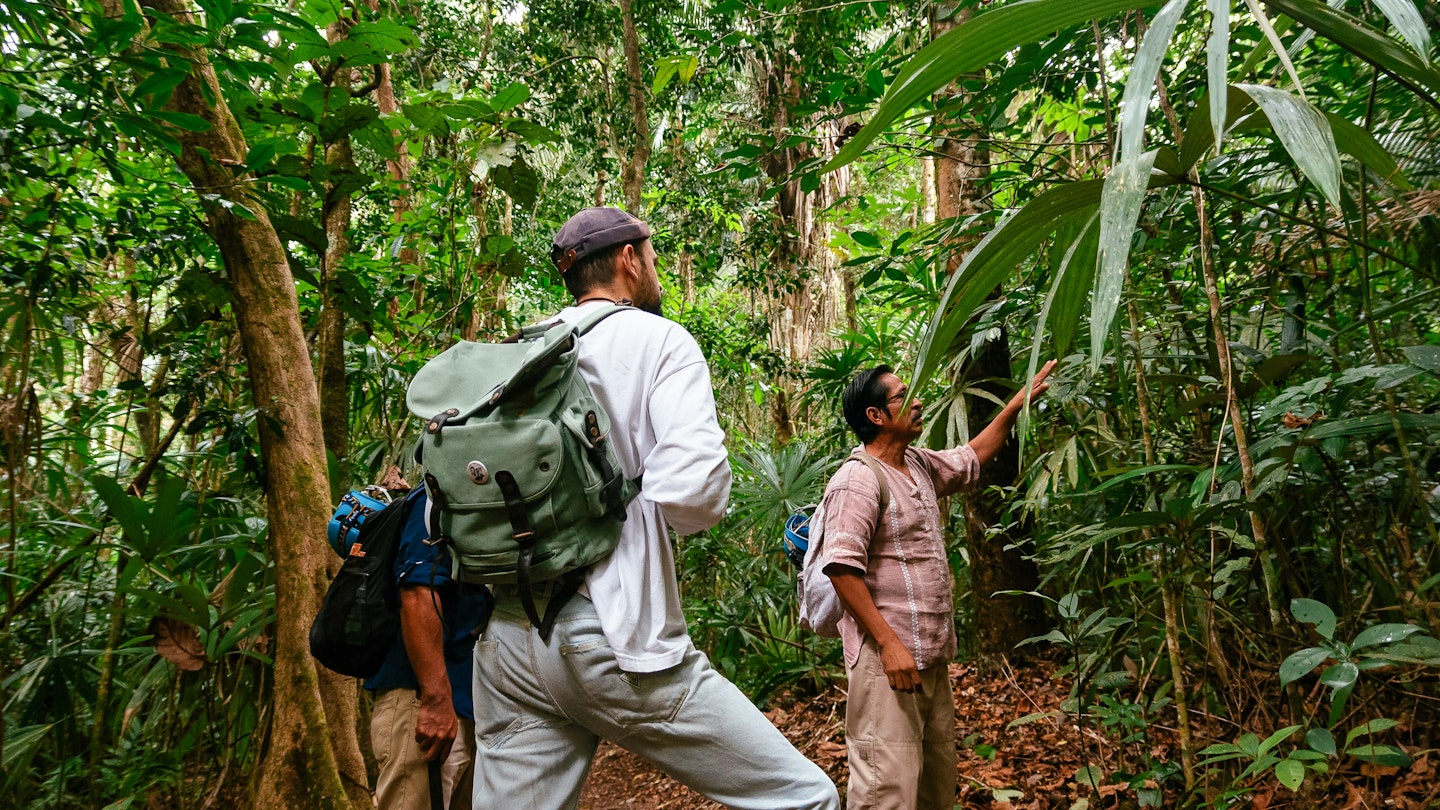A seldom-visited corner of Belize offers writer Alex Schechter a fresh perspective on his battle with cancer.
A month before I flew to Belize last fall, I called my oncologist. I was planning to visit a national park named after Don Elijio Panti, a famous Maya healer, where I hoped to learn about native medicinal plants. I sought my doctor’s opinion on the “bush medicine” that remains popular in his home country.
I began seeing Dr. Grant soon after my surgery for testicular cancer, five years ago. Despite the sobering nature of my visits, our conversations were always enjoyable. He knows I’m a travel writer and often hinted that I should write about Belize. When I explained my search, he recalled how his grandmother cured ailments using roots and leaves from her backyard. He admitted that sometimes, those remedies worked effectively, but he was more skeptical as a physician.
“People begin making broader claims,” he explained. “They say, ‘This one plant cures everything from diabetes to cancer to memory loss.’ Like all things, it becomes outlandish.” I learned that Dr. Grant had been treating cancer patients in Belize since 2008 at the country’s first cancer clinic, something that hadn’t come up earlier in our discussions.
Away from the beach, into the rainforest
Until now, my impressions of Belize were mostly based on photos of tropical white sand beaches and blissed-out snorkelers. This trip, however, involved winding jungle trails, sacred Maya caves, and medicinal tree bark. I found a hotel, the Gaïa River Lodge, located at the edge of Elijio Panti National Park, a sprawling wilderness in the west Belize district known as Cayo. The hotel offered guided “shaman” tours through the forest, which felt like a good starting point to better understand the role of traditional medicine in the country.
Dr. Grant seemed pleased that I had chosen Cayo, a less-traveled area of Belize. He remarked that tourists tend to flock to all-inclusive resorts on the cayes, missing out on the lush inland region. “They miss out on all that green,” he said.
Botanical treatments with a Maya healer
On a drizzly Saturday morning, I met with Jose Magaña, a practicing Maya healer well-versed in the native flora of Elijio Panti National Park. He greeted me in the lobby of Gaïa River Lodge wearing baggy cargo pants and a woven linen shirt. Soon, we were traipsing through the rainforest, crushing allspice leaves and slicing Billy Webb bark to use as mosquito repellent.
I learned that Magaña’s grandfather was a nephew of Elijio Panti, the park’s namesake. Like his famous relative, Magaña takes his role as a healer seriously. His patients come from all over the Cayo district, seeking treatment for diabetes, migraines, asthma, and various other afflictions. However, as he explained, curing involves more than just picking the right leaf: “What’s missing are the prayers,” he said, snapping off a purplish stem of bullhorn acacia. “You cannot harvest the herbs just because you want to; you have to talk to the plants.”

Soon, Magaña began hopping on a red dirt mound, causing a small army of leafcutter ants to emerge. He seized one and allowed its mighty jaws to clamp down on his pinky nail. When he pulled, the ant did not let go. This, he explained, was the Maya precursor to surgical stitches: a series of leafcutter ants attach directly to the torn skin, sealing the wound with their powerful bites. I winced at the thought of putting their scissor-shaped heads on a stitched incision.
Into the place of fright
We crossed the shallow Vaqueros Creek, climbed up fields where thigmotropic weeds folded at my touch, and delved back into the dense jungle. At the end of a corridor filled with massive cohune palms, we reached the entrance to an underground cave. Magaña referred to this as Xibalba, a sacred Maya cave meaning “place of fright.” However, I felt neither frightened nor anxious as Magaña gently lowered himself and uttered a welcome prayer before we entered. Afterward, we strapped on helmets with flashlights and climbed down a ladder into the murky hollow.

Magaña refers to himself as a h’men—a Yucatec Maya term meaning “one who knows.” He carefully avoids using the word shaman, often associated with sorcery and dark spirits. We ducked under jagged stalactites, navigated through labyrinthine tunnels, and finally reached the cave’s innermost chamber, where we sat for a traditional Maya ceremony. Magaña lit four white candles in the dirt, filled a bowl with piney resin for incense called copal, and unraveled cloth containing several crystals and an obsidian blade.
“Some people get confused,” he stated, “They see a stone and think ‘magic.’ No! These are symbols,” he clarified. Rather than chants or invoking spirits, he focused on setting a good example for younger generations. As we sat in silence, he sprinkled dried rosemary into the burning copal. The smoke swirled upwards, and the chamber took on a ghostly quality, as if the collective prayers of past generations lingered in the air. It felt like the safest place I could imagine.

When we emerged into daylight, the forest was serene and dappled in sunlight. I asked Magaña why he felt comfortable sharing such an intimate ritual with someone like me. “I want to show people that we, the Maya, are still here,” he pointed out. “We dress in modern clothes, but that doesn’t mean we’re not Maya.”
Elijio Panti National Park recovered
Elijio Panti National Park was established in 2001 and stands as a cultural symbol for the indigenous people in this Belize corner. However, its protected status has faced challenges. In 2009, the Itzama Society, the local all-Maya council managing the park with the Belize Forest Department, lost its stake. For ten years, the park languished amid poaching and logging activities. “It was sad,” recalled Maria Garcia, the society’s chairwoman and Don Elijio Panti’s niece. “This forest is our life. We have grown with it. It’s part of us.”
The Itzama Society regained co-management of the park in 2019 after two years of negotiation, leading Garcia to focus on community outreach. She began inviting Maya students as young as 13 for workshops led by elders. “The young people are hungry for it,” she noted. “For some, it was their first time in a Maya ceremony.”

Seeing the park through a ranger’s eyes
Two days after my hike with Jose Magaña, I ventured into the park’s remote interior, receiving a private tour from Abdon Tzib, a ranger from neighboring San Antonio. Tzib is one of four volunteers managing a park area the size of Manhattan. As we walked beneath the pristine canopy of sapodilla trees, he pronounced the park’s full name—Noj Kax Meen Elijio Panti National Park—and explained it references a Yucatec Maya term meaning “the grandmother forest of healers.”
Although Tzib does not consider himself a h’men, he pointed out the medicinal properties of fragrant lemongrass, avocado leaf, wild pineapple leaves, and firebush, believed to help with women’s menstrual cramps. “That’s a really good plant to have around,” he explained, impressing me with his knowledge and affection for these plants.
A personal approach to healing
I never mentioned my cancer to Magaña or Tzib, as it plays a minimal role in my life today. Five years post-recovery, I’m more intrigued by other cultures’ attitudes towards sickness than the specifics of my past diagnosis.

Walking with Magaña and Tzib, both of whom continue the h’men tradition popularized by Elijio Panti, I was struck by the Maya’s personal, holistic approach to healing. I couldn’t help but wonder how oncologists in the US would benefit from considering a patient’s emotional state when prescribing treatments.
Magaña noted that his patients often believed they were victims of an enemy’s curse. He challenged such reasoning: “Not everything that happens to you is black magic,” he warned. “Sometimes, we create our problems. If we don’t accept that we’re suffering, how can we heal?”

From the medicine of a jungle to a cancer clinic
On my last day in Belize, I drove three hours to Dangriga to visit the cancer center founded by Dr. Grant. I aimed to compare my lessons in the jungle against the realities of invasive treatments like chemotherapy. (Testicular cancer has a 95% survival rate and rarely requires radiation or chemotherapy.)
At the modest two-story building, which was Dr. Grant’s childhood home, a nurse led me through a small waiting room stocked with American magazines and pictures of tropical beaches. Only one patient was present: a 5-year-old boy receiving an injection for leukemia, accompanied by his smiling father and younger brother, who was distracted by a video game.

Unlike the highlands of Cayo, coastal Belize felt muggy and hot. While waiting, I quizzed the nurse about home remedies like noni juice and soursop tea, which many Belizeans consider natural cancer antidotes. He shrugged, stating, “If it works, it works. But with targeted therapy, we can quantitatively assess the results. We can back that up scientifically.”
Another issue involved early detection. Most patients, he explained, delay visiting the clinic until serious symptoms develop. Once cancer metastasizes, it’s unlikely any treatment, chemical or otherwise, will help.
My journey with cancer
I reflected on the summer of 2016—the week I discovered my lump, saw a urologist, and underwent surgery the next day. I found my cancer early, preventing substantial damage. I was fortunate enough to access quality healthcare and have a supportive family.
Post-surgery, I felt reborn and developed newfound respect for my body’s subtle functions. This awareness—an understanding of my feelings—has remained, which, as any healer would affirm, is just as vital as the medicine itself.





